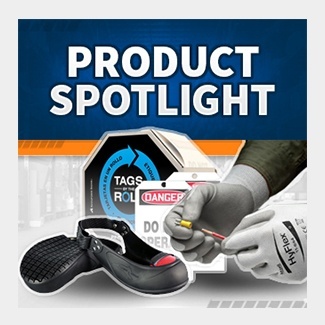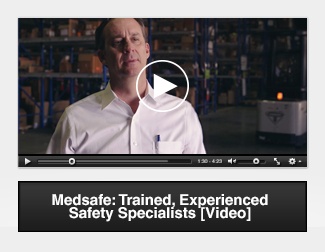Is there much of a difference? You’ll often hear both phrases used interchangeably while describing the overall fall protection industry –which is a bit mind blowing because they simply aren’t the same thing at all. So, what is the difference in fall protection vs fall prevention?
Part of the problem is that OSHA defines fall protection as “any equipment, device or system that prevents a worker from falling from an elevation or mitigates the effect of such a fall.” They lump these two separate safety terms into one, probably confusing almost everyone who attempts to pin-point the significance to each.
It’s just a few letters changed out in the words, but those few letters change the subject drastically. Understanding the importance of both individual topics can be the difference between being the recipient of knockout punch and a jobsite win.
In this Corner We Have … Fall Prevention!

[The steps you take in order to keep an accidental fall from happening]
Let’s just take a minute to think about this. You don’t jump into the ring; knock over the ref, cut through the ropes and barrel into your opponent without your helmet or mouth guard, do you?
No.
When you’re headed into a risky situation, if you’re interested in making it out alive, you take steps to prevent an accident. Steps like making sure the ring (and ref) are in good operational order, wearing your protective gear, staying aware of your surroundings and researching your opponent.
Fall prevention is the equivalent of those common sense tasks that need to be completed before putting someone into a hazardous situation.
Common Sense Prevention
- Eliminate hazards wherever possible. Let’s say that one again. E-lim-i-nate hazards wherever possible
- Assess task areas daily. If there is a way to complete a task without placing a worker at a potential fall risk, that’s the best option. Train employees to spot unnecessary risks and avoid them completely.
- Limit access to fall hazards.
- Create a barrier between a worker and the fall hazard by using guardrails, gates, covers, railings or cages. Fatalities can be prevented by simply having devices such as these in place. Real lives are affected by accidental falls. Lives that won’t ever sit back, drink a beer and remember the good ole days because a relatively inexpensive, easy to access safety product wasn’t used. That’s senseless.
- Restrain worker movements.
- Use a positioning system such as a lifeline, where workers can tie off with a pre-determined length lanyard or positioning device, keeping them from reaching fall hazards at all.
If prevention was simple, it might be better understood; but it honestly isn’t. OSHA has set forth very specific fall protection systems regulations regarding prevention devices in CFR 1910.29. There is a lot of information contained in that regulation that can seem overwhelming. Don’t make the mistake of not getting help when you need it. A professional hazard assessment can help your company adhere to these requirements. Need help avoiding violations at your worksite?
Download the Contractor's Safety Site Field Guide now
And in this Corner, the Heavyweight Favorite … Fall protection!

[Products used to minimize injuries received from an accidental fall]
There are going to be situations where you can’t take reasonable steps to prevent falls. That’s the reality of this industry. When you find yourself dealing with fall risks that cannot be eliminated by prevention, as an employer, you have a responsibility to provide fall protection. And that’s not all. OSHA requires employers to:
- Provide working conditions that are free of known dangers
- Keep floors in work areas in a clean and, so far as possible, a dry condition
- Select and provide required personal protective equipment at no cost to workers
- Train workers about job hazards in a language that they can understand
Let’s look at some options for meeting those fall protection requirements.
Common Sense Protection
- There will never be a substitute for being alert, aware and prepared.
- This OSHA training resource is meant to create fall protection awareness on job sites and in facilities. Training is the most valuable piece of PPE in any industry.
- Fall arrest systems can save lives.
- Body harnesses , horizontal lifelines, anchors and self-retracting lifelines are some of the different styles of protection available. Choosing the right equipment is no small feat. Taking all risk factors and situational circumstances into account is a job best left to professionals. Seek out a safety specialist who can make your road to success smoother.
- Consider less common alternate protection.
- Aerial lifts are mechanical devices that replace ladders, scaffolding or other elevated work surfaces. They provide more flexibility to your workers and are a perfect anchor point to restrain a worker from falling –making aerial lifts a one-two punch by bringing prevention into the protection process.
Comparing Fall Prevention and Fall Protection
Round 1: Usability
With fall restraint or fall arrest systems, a degree of burden falls on the employee; inspecting the PPE before each use and learning how to properly don and doff the equipment.
Fall protection measures require work on the employee's part, as opposed to fall prevention measures where there is little or no burden to the worker. You can only put your faith in an employee’s willingness to consistently take on these burdens when they have been properly trained. Make sure you’re confident they’ve become alert to the risk potential if they don’t comply. For this reason alone, prevention is the winner of this round. Need help choosing the right fall harness? We're here to help, read our ultimate guide here.
Round 2: Cost
Fall prevention equipment like guardrails can have a higher up-front cost, but they save you big time down the road with low maintenance and reusability.
Fall protection PPE has comparatively lower up-front costs initially. Though, once you factor in hidden costs including: training, equipment maintenance and even possible setup time, the clear-cut value isn’t so clear cut anymore. A mix of both is the most practical solution. A draw.
Round 3: Potential for injuries
We talked about this. Prevention eliminates hazards. Fall protection by nature is present because of the potential for injury. OSHA prefers prevention. So should you. It’s clear; protection has to finish this fight as the runner up.
Ding, Ding, Ding! Fall Prevention Wins!









